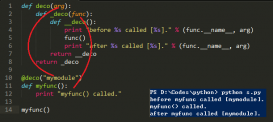本文实例讲述了Python单例模式的使用方法。分享给大家供大家参考。具体如下:
方法一
class Singleton(object):
__instance = None
__lock = threading.Lock() # used to synchronize code
def __init__(self):
"disable the __init__ method"
@staticmethod
def getInstance():
if not Singleton.__instance:
Singleton.__lock.acquire()
if not Singleton.__instance:
Singleton.__instance = object.__new__(Singleton)
object.__init__(Singleton.__instance)
Singleton.__lock.release()
return Singleton.__instance
1.禁用__init__方法,不能直接创建对象。
2.__instance,单例对象私有化。
3.@staticmethod,静态方法,通过类名直接调用。
4.__lock,代码锁。
5.继承object类,通过调用object的__new__方法创建单例对象,然后调用object的__init__方法完整初始化。
6.双重检查加锁,既可实现线程安全,又使性能不受很大影响。
方法二:使用decorator
def singleton(cls):
instances = {}
def getInstance():
if cls not in instances:
instances[cls] = cls()
return instances[cls]
return getInstance
@singleton
class SingletonClass:
pass
if __name__ == '__main__':
s = SingletonClass()
s2 = SingletonClass()
print s
print s2
也应该加上线程安全
class Sing(object):
def __init__():
"disable the __init__ method"
__inst = None # make it so-called private
__lock = threading.Lock() # used to synchronize code
@staticmethod
def getInst():
Sing.__lock.acquire()
if not Sing.__inst:
Sing.__inst = object.__new__(Sing)
object.__init__(Sing.__inst)
Sing.__lock.release()
return Sing.__inst
希望本文所述对大家的Python程序设计有所帮助。












